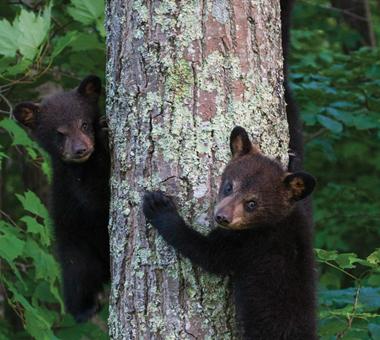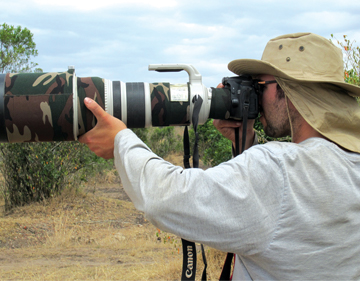
“One of these got way too close to me at Shenandoah National Park. Luckily the mother huffed at him and made him come back. I backed up, and luckily he went back and left my equipment alone.”

Wildlife photographer Mark Hendricks’ ultimate goal is conservation of the animals whose images he captures.
Mark Hendricks’ love for animals started in a most unlikely locale: his childhood home in Southwest Baltimore.
Wildlife in that part of the city doesn’t stray far from feral cats, squirrels, and yes, the occasional rat, but his mother was determined to show her sons another side of the natural world. She’d order him and his two brothers to put down their video games and go outside, which was no easy task. Patapsco State Park became a favored destination, as did the Maryland Zoo and National Aquarium.

Hendricks ’10 began volunteering at the aquarium at the age of 15, and after college worked there full time. “I had two dreams as a kid,” says Hendricks, 36, who used to get coffeetable books about rain forests, the oceans, and wildlife. “I wanted to work with marine mammals, and I wanted to photograph for National Geographic.”
Still, it wasn’t until he was writing a paper for a graduate school class at TU, where he was in the experimental psychology program focusing on animal cognition, that he had an epiphany. “Who’s going to read this?” he thought.
“How do you inspire people about conservation when you have almost 8 billion people on this planet?” he says. “Many people are just doing the work of the world; they don’t have time to think about these things. So how do you inspire people? I realized photography is the way you can do that in an instant.”
From the time he picked up his first rectangular 110-millimeter camera and loaded it with a roll of Kodak film, Hendricks has been fascinated with photography. But he never considered it as a potential job until that moment.
Fast forward to today. Large plastic bins packed with photography equipment — tripods, duct tape, zoom lenses and Canons — crowd his office in the North Baltimore apartment he shares with his wife, Carolina Giraldo ’09, and their 1-year-old daughter, Liliana. A framed photo of a beautiful lion icily staring straight at him hangs on one wall, a shot he took during a career-changing trip to Africa in 2016.
Propped on a bookshelf is a copy of Natural Wonders of Assateague Island, his very own coffee-table book, which was released in 2017. Hendricks’ writing and
photography
have been published in numerous magazines, including National Parks Traveler and Nature Photographer, although that National Geographic assignment has remained elusive. He’s particularly interested in the Chesapeake Bay
Watershed, which is what led to the book project.
“Eighteen million people live in the Chesapeake Bay Watershed. Most people hear Chesapeake Bay and think of a bridge going over a body of water on their way to the beach. The Chesapeake Bay Watershed has always been fascinating to me because it is the largest watershed in North America. It’s the third-largest in the world. And we live in it,” he says as if he’s astonished that it’s actually true.
Hendricks has explored Assateague Island, an 18,000-acre barrier island off the Maryland and Virginia Eastern Shore, by foot, air, surf and kayak. Although the cover of his book features an image of the island’s iconic wild horses — which are non-native, he’s quick to point out — inside he concentrates more on lesser known animals like the threatened piping plover, one of 300 bird species that nest or feed there. He spent countless hours tracking down a cagey river otter, and turned his lens on foxes, seals, horseshoe crabs and snowy owls.
Patience, Hendricks says, is the most important virtue a nature photographer can possess.
“I don’t lure or bait my subjects,” he says. “When they get close to me, it’s on their own accord. Could I make quicker money selling to calendars by going to a game farm? I guess you could, but you don’t see the wilderness in their eyes.”
On occasion, Hendricks has witnessed that wildness a bit too closely for comfort. In Shenandoah National Park he was on assignment for Earth Island Journal photographing a rare salamander that lives on a mountain slope when he heard a noise that sounded like an avalanche.
“I turned around and there was a black bear walking right toward me,” he recalls. “I started clapping saying, ‘It’s just me, a human.’ Thankfully he turned and went back down the mountain.”
It was also in Virginia where Hendricks finally came face-to-face with a bobcat, an animal he’s been pursuing for years. On a foggy spring day he was hiking to a waterfall when one wandered onto the trail.
“Usually if you’re lucky enough to see a bobcat, it takes off,” he says. “This one just looked at me, I looked at it, and it went back to stalking. I let it get ahead of me about 10 yards or so before I got on my hands and knees and crawled through the woods. When it would stop I would stop. When it went on I would go on. It let me follow it. All of a sudden it turned and hopped over a log, got some type of rodent, and then it was off. I never saw it again.”
Hendricks’ latest project focuses on Appalachia. Four of the five major rivers that
flow into the Chesapeake Bay originate in the mountain range, which is where he spends
much of his time these days when he’s not teaching in TU’s Department of Psychology.
Roaming through the forest among the mammals, reptiles, birds and insects, armed with
a camera and unrelenting curiosity, is where Hendricks feels most at peace. No one
needs to force him outside now.
When Mark Hendricks went to Africa in 2016, he didn't want to stay at a Hilton outside a game reserve.
“I wanted it to be an adventure,” he says.
Traveling on their own through Kenya and Tanzania, Hendricks and his wife, Carolina Giraldo ’09, encountered lions, hippos, cape buffalo and elephants. He photographed two of the remaining 30 or so black rhinos in the Serengeti for Africa Geographic, and snapped thousands of images of animals in their natural environments. At night they heard elephants, lions and hyenas sniffing around their tent. Not exactly white noise. The most transformative part of the trip came in Rwanda, where he photographed mountain gorillas.
“The gorillas would have been lost if it wasn’t for responsible ecotourism,” he says.
“You have the bush meat trade and other poaching issues. But 20 years post-genocide they’ve really been able to transform part of their economy. Ecotourism creates jobs. People that used to be poachers are now porters. Now the mountain gorilla is a revered animal in Rwanda. That really inspired me to think about how we can do more of that type of conservation here.”